Foundations can be categorised as shallow foundations or deep foundations. Shallow foundations are typically used where the loads imposed by a structure are low relative to the bearing capacity of the surface soils. Deep foundations are necessary where the bearing capacity of the surface soils is insufficient to support loads imposed and so they are transferred to deeper layers with higher bearing capacity. For Construction Invoice Templates check Trevozo.com.
Use of pile foundation
Pile foundations are principally used to transfer the loads from superstructures, through weak, compressible strata or water onto stronger, more compact, less compressible and stiffer soil or rock at depth, increasing the effective size of a foundation and resisting horizontal loads. They are typically used for large structures, and in situations where soil is not suitable to prevent excessive settlement.
As pile foundations carry a lot of load, they must be designed very carefully. A good engineer will study the soil the piles are placed in to ensure that the soil is not overloaded beyond its bearing capacity.
Every pile has a zone of influence on the soil around it. Care must be taken to space the piles far enough apart so that loads are distributed evenly over the entire bulb of soil that carries them, and not concentrated into a few areas.
Following are the situations when using a pile foundation system can be
- When the groundwater table is high.
- Heavy and non-uniform loads from superstructure are imposed.
- Other types of foundations are costlier or not feasible.
- When the soil at shallow depth is compressible.
- When there is the possibility of scouring, due to its location near the river bed or seashore, etc.
- When there is a canal or deep drainage systems near the structure.
- When soil excavation is not possible up to the desired depth due to poor soil condition.
- When it becomes impossible to keep the foundation trenches dry by pumping or by any other measure due to heavy inflow of seepage.
Classifications of pile foundation
The purpose of a pile foundation is to transfer and distribute load through a material or stratum with inadequate bearing, sliding or up- lift capacity to a firmer stratum that is capable of supporting the load without detrimental displacement. A wide range of pile types is available for applications with various soil types and structural requirements.Piles may be classified by their basic design function (end-bearing, friction or a combination) or by their method of construction (displacement (driven) or replacement (bored)).
End Bearing Piles:
In end bearing piles, the bottom end of the pile rests on a layer of especially strong soil or rock. The load of the building is transferred through the pile onto the strong layer. In a sense, this pile acts like a column. The key principle is that the bottom end rests on the surface which is the intersection of a weak and strong layer. The load therefore bypasses the weak layer and is safely transferred to the strong layer.
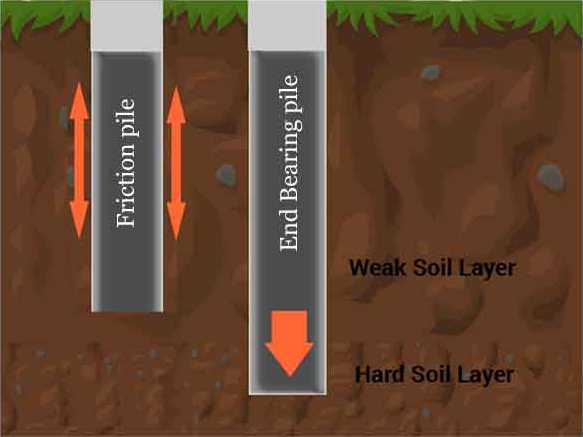
Friction Piles:
Friction piles work on a different principle. The pile transfers the load of the building to the soil across the full height of the pile, by friction. In other words, the entire surface of the pile, which is cylindrical in shape, works to transfer the forces to the soil.
To visualise how this works, imagine you are pushing a solid metal rod of say 4mm diameter into a tub of frozen ice cream. Once you have pushed it in, it is strong enough to support some load. The greater the embedment depth in the ice cream, the more load it can support. This is very similar to how a friction pile works. In a friction pile, the amount of load a pile can support is directly proportional to its length.
Pile foundations are deep foundations. They are formed by long, slender, columnar elements typically made from steel or reinforced concrete, or sometimes timber. A foundation is described as ‘piled’ when its depth is more than three times its breadth.A pile is basically a long cylinder of a strong material that is pushed into the ground to act as a steady support for structures built on top of it.
Classification of pile foundation based on the effect of soil:
Driven piles:
Driven piles, also known as displacement piles, are a commonly-used form of building foundation that provide support for structures, transferring their load to layers of soil or rock that have sufficient bearing capacity and suitable settlement characteristics. Driven piles are commonly used to support buildings, tanks, towers, walls and bridges, and can be the most cost-effective deep foundation solution. They can also be used in applications such as embankments, retaining walls, bulkheads, anchorage structures and cofferdams..
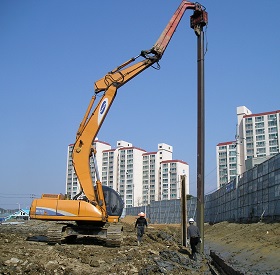
Bored piles:
Bored piles, also known as replacement piles, are a commonly-used form of building foundation that provide support for structures, transferring their load to layers of soil or rock that have sufficient bearing capacity and suitable settlement characteristics. Bored piles are piles where the removal of spoil forms a hole for a reinforced concrete pile which is poured in situ. The spoil is replaced by the pile, hence ‘replacement’ piles as opposed to displacement piles where soil is forced away by driving or screwing the pile. Bored piles are used primarily in cohesive subsoils for the formation of friction piles and when forming pile foundations close to existing buildings. They are popular in urban areas as there is minimal vibration, where headroom is limited, where there is no risk of heave, and if there is a need to vary the length of the piles.
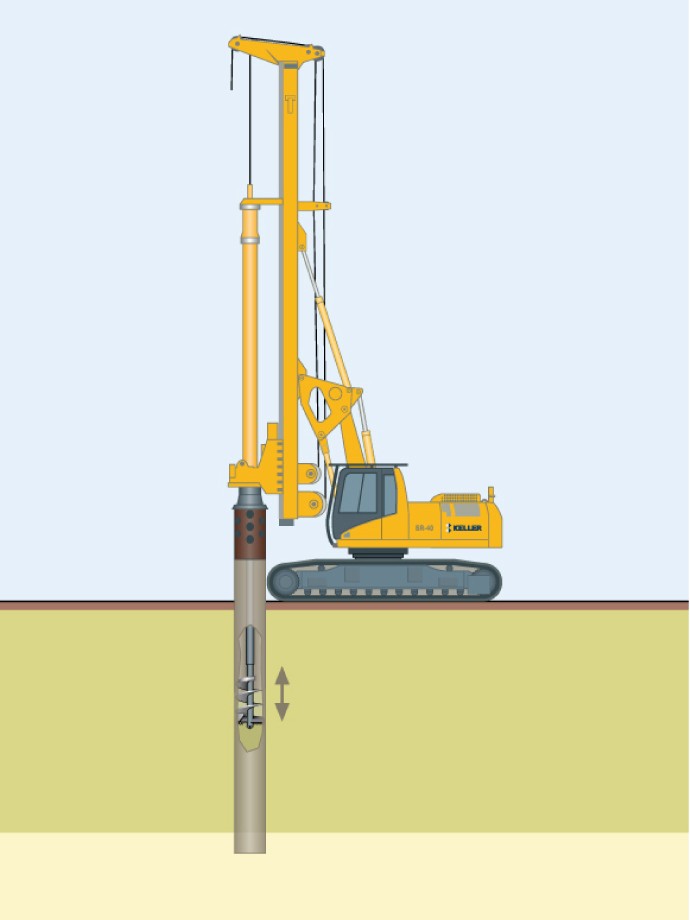
Screw pile:
Screw pile foundations are a type of pile foundation with a helix near the pile toe so that the piles can be screwed into the ground. The process and concept is similar to screwing into wood. A screw pile may have more than one helix (also called a screw), depending on the usage and the ground conditions. Generally, more helices are specified if a higher load is required or softer ground is encountered.
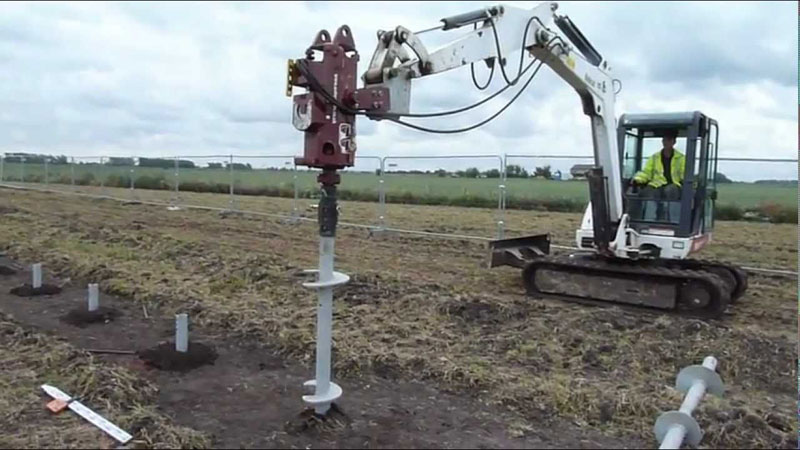
Classification based on Material of Piles Construction:
Timber piles:
Timber piles are the oldest of all the contemporarily used piles. They are usually precast displacement piles installed with the driving method, or less commonly, the vibratory method. The natural convergence of pile shafts allows us to obtain a relatively high pile load capacity. Properly applied, they are a highly economical, efficient and safe foundation solution, both for temporary and permanent structures. This can be justified by a number of historical buildings founded on timber piles that have been in operation for thousands of years. Timber piles applied for the purposes of permanent structures are pressure-impregnated

Steel piles:
Driven steel piles are installed using impact or vibration hammers to a design depth or resistance. You can install the complete suite of driven piles from small diameter tube piles to large diameter steel caissons to support your project. Driven piles gain geotechnical capacity efficiently by displacing the soil around the shaft and compacting the soils at the toe during installation. Steel tubes can be driven either closed or open ended. The energy to drive the piles is provided by either a high frequency oscillating hammer or a percussion hammer.

Concrete piles:
Concrete piles are common structural foundation elements used to support offshore structures such as bridges, oil-rigs, and floating airports. The use of offshore structures is still a fairly new technique and there is still much research to be done in this field. The loading of an offshore structure consists of two components: vertical structural loads and lateral wave loads. The interaction of these two loading components has a significant impact on how the pile reacts and the way the stresses are distributed through the pile. In addition, the pile will react differently when subjected to a small structural load than to a large structural load.
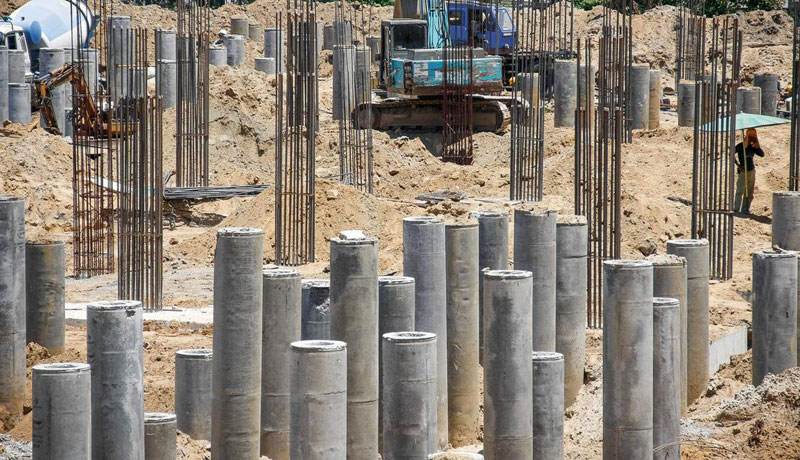
Pile installation method
Piles are installed using a number of different methods, each of which is selected according to need. The various factors which influence what type of pile you’ll need and the ways in which your piling can be installed might include:
- The depth of your excavation
- The material your piles are made of
- The angle at which your piles are being driven
- Environmental issues which may impact local residents, flora or fauna
Once your needs have been assessed, you will feel better able to decide which of the two most common pile installation methods you will use for your project: displacement or replacement. Displacement piling installation refers to the method of driving piles into the ground without first removing any of the soil or other material. Replacement piling installation refers to the method of first digging out a hole, into which the pile is then maneuvered.
Decisions on the type of instrumentation for pile load tests must be an integral part of the design. The designer should select instrumentation that has sufficient accuracy to measure the required data. Permanent instrumentation is used to gather data relating to the state of stress and behavior of the pile under service load conditions. Useful knowledge can be gained from permanent instrumentation, not only about the behavior of a particular pile foundation, but also about analysis and design assumptions in general.
Criteria and methods for selecting the best type of pile foundation
Structural and Geotechnical Coordination. A fully coordinated effort from geotechnical and structural engineers and geologists should ensure that the result of the pile foundation analysis is properly integrated into the overall foundation design. This coordination extends through plans and specifications, preconstruction meetings, and construction.
Failure Considerations – Structure or foundation failures can be categorized as an actual collapse or a functional failure. Functional failure can be due to excessive deflection, unacceptable differential movements, excessive vibration, and premature deterioration due to environmental factors. For critical structures, failure to meet functional requirements may be as serious as the actual collapse of a lesser structure. Therefore, designers should be cognizant not only of the degree of safety against collapse but also of effects of settlement and vibration on the functional performance.
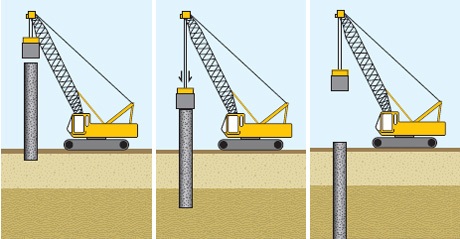
Safety Considerations- Factors of safety represent reserve capacity which a foundation or structure has against collapse for a given set of loads and design conditions. Uncertain design parameters and loads, require a higher factor of safety than required when the design parameters are well known. For most hydraulic structures, designers should have a high level of confidence in the soil and pile parameters and the analysis. Therefore, uncertainty in the analysis and design parameters should be minimized rather than requiring a high factor of safety. For less significant structures, it is permissible to use larger factors of safety if it is not economical to reduce the uncertainty in the analysis and design by performing additional studies, testing, etc. In such cases, similar to the risk considerations in ufabet, a pragmatic approach may be taken to balance safety and cost-effectiveness.
Soil-Structure Considerations – The functional significance and economic considerations of the structure will determine the type and degree of the foundation exploration and testing program, the pile test program, the settlement and seepage analyses, and the analytical models for the pile and structure. For critical structures the foundation testing pro- gram should clearly define the necessary parameters for the design of the pile foundation, such as soil types and profiles, soil strengths, etc.
Info & Image Source – Vpgroundforce.com, engineering discoveries, cedengineering.com, weebly.com, science direct,

